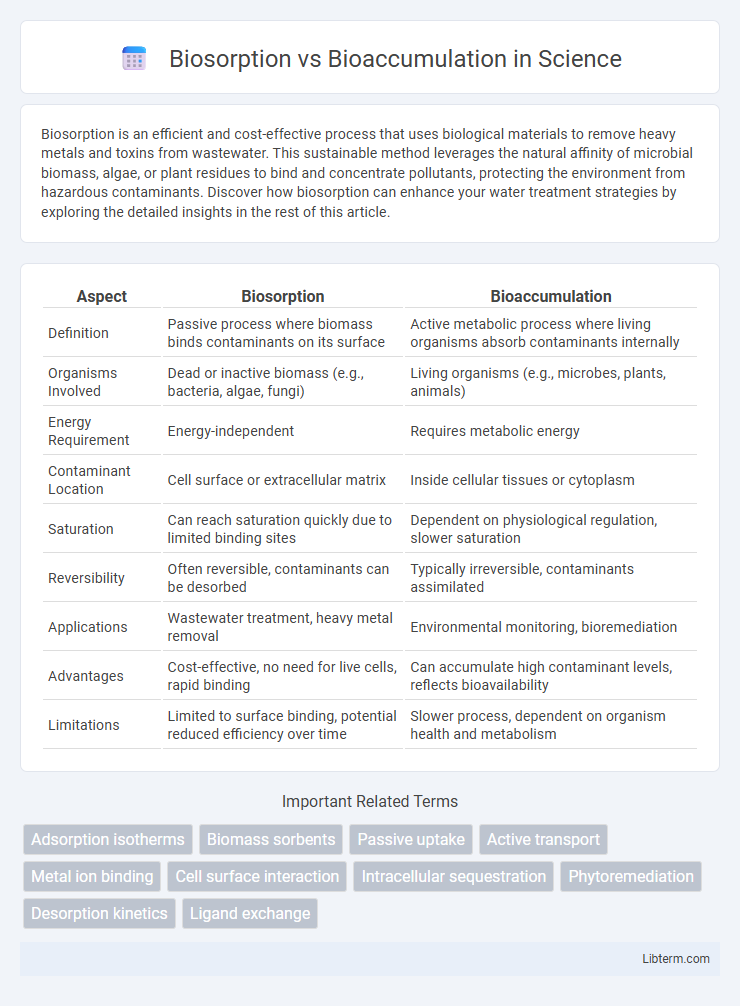Biosorption is an efficient and cost-effective process that uses biological materials to remove heavy metals and toxins from wastewater. This sustainable method leverages the natural affinity of microbial biomass, algae, or plant residues to bind and concentrate pollutants, protecting the environment from hazardous contaminants. Discover how biosorption can enhance your water treatment strategies by exploring the detailed insights in the rest of this article.
Table of Comparison
| Aspect | Biosorption | Bioaccumulation |
|---|---|---|
| Definition | Passive process where biomass binds contaminants on its surface | Active metabolic process where living organisms absorb contaminants internally |
| Organisms Involved | Dead or inactive biomass (e.g., bacteria, algae, fungi) | Living organisms (e.g., microbes, plants, animals) |
| Energy Requirement | Energy-independent | Requires metabolic energy |
| Contaminant Location | Cell surface or extracellular matrix | Inside cellular tissues or cytoplasm |
| Saturation | Can reach saturation quickly due to limited binding sites | Dependent on physiological regulation, slower saturation |
| Reversibility | Often reversible, contaminants can be desorbed | Typically irreversible, contaminants assimilated |
| Applications | Wastewater treatment, heavy metal removal | Environmental monitoring, bioremediation |
| Advantages | Cost-effective, no need for live cells, rapid binding | Can accumulate high contaminant levels, reflects bioavailability |
| Limitations | Limited to surface binding, potential reduced efficiency over time | Slower process, dependent on organism health and metabolism |
Introduction to Biosorption and Bioaccumulation
Biosorption is a passive process where biological materials, such as algae, bacteria, or fungi, adsorb heavy metals and toxins onto their cell surfaces, effectively removing contaminants from aqueous solutions. Bioaccumulation involves the active uptake and retention of substances within the cells or tissues of living organisms, leading to concentration build-up over time. Both mechanisms play crucial roles in bioremediation, with biosorption offering rapid contaminant removal and bioaccumulation enabling long-term sequestration of pollutants.
Fundamental Definitions: Biosorption vs Bioaccumulation
Biosorption refers to the passive binding of heavy metals or contaminants onto the surface of biological materials, often involving cell wall components without metabolic activity. Bioaccumulation describes the active uptake and internal storage of substances within an organism's cells through metabolic processes. Understanding these fundamental differences is crucial for applications in bioremediation and environmental detoxification strategies.
Mechanisms of Biosorption in Environmental Remediation
Biosorption involves the passive binding of heavy metals and pollutants onto the surface of biological materials like algae, fungi, and bacteria, primarily through mechanisms such as ion exchange, complexation, adsorption, and micro-precipitation. Unlike bioaccumulation, biosorption does not require metabolic energy and occurs rapidly, making it efficient for removing contaminants from wastewater and soil in environmental remediation. Key factors influencing biosorption efficiency include pH, temperature, biomass type, and pollutant concentration, which are critical for optimizing treatment processes in sustainable pollutant management.
Mechanisms of Bioaccumulation in Living Organisms
Bioaccumulation in living organisms involves the uptake and retention of contaminants through biological processes such as passive diffusion, active transport, and endocytosis, where substances accumulate in cells or tissues over time. This mechanism often leads to biomagnification as contaminants move up the food chain, concentrating in higher trophic levels. In contrast, biosorption primarily involves the binding of pollutants onto cell surface structures like cell walls through physicochemical interactions without metabolic energy expenditure.
Key Differences Between Biosorption and Bioaccumulation
Biosorption involves the passive binding of heavy metals or contaminants onto the surface of biological materials such as microbial biomass, without metabolic energy, making it a rapid and reversible process. Bioaccumulation refers to the active uptake and accumulation of substances within the living cells of organisms, requiring metabolic activity and leading to intracellular concentration over time. Key differences lie in the mechanisms, with biosorption being surface-based and metabolism-independent, while bioaccumulation is intracellular and metabolism-dependent, influencing their applications in bioremediation and environmental monitoring.
Factors Influencing Biosorption Efficiency
Biosorption efficiency is influenced by key factors such as pH, temperature, biosorbent concentration, and initial metal ion concentration, which affect the affinity and capacity of the biosorbent material. The type of biosorbent, its surface properties, and the presence of competing ions also play critical roles in metal uptake during biosorption. Understanding these parameters enables optimization of biosorption processes for effective removal of heavy metals from wastewater.
Factors Affecting Bioaccumulation Processes
Bioaccumulation is influenced by factors such as the chemical properties of pollutants, organism metabolism, exposure duration, and environmental conditions like temperature and pH. Lipophilicity and molecular size determine the ease with which contaminants penetrate biological membranes, affecting accumulation rates. Organism-specific traits including age, trophic level, and detoxification mechanisms also critically impact the bioaccumulation process.
Advantages and Limitations of Biosorption
Biosorption offers the advantage of rapid heavy metal removal from wastewater using non-living biomass, resulting in low-cost, efficient, and environmentally friendly treatment with minimal nutritional requirements. Its limitations include desorption challenges and reduced effectiveness for complex multi-metal solutions, as well as potential saturation of biosorbent sites requiring regeneration. Biosorption's ability to handle high metal concentrations without metabolic dependency contrasts with bioaccumulation, where living organisms uptake contaminants metabolically, often slower and more sensitive to environmental conditions.
Advantages and Limitations of Bioaccumulation
Bioaccumulation offers the advantage of selectively concentrating contaminants within living organisms, enabling the efficient removal of pollutants from environments such as water and soil. However, its limitations include potential toxicity to the bioaccumulating organisms and slower processing times compared to biosorption methods. The reliance on metabolic activity in bioaccumulation restricts its application to viable organisms, posing challenges in extreme or contaminated conditions.
Applications and Future Perspectives in Pollution Control
Biosorption utilizes non-living biomass to bind and remove heavy metals and pollutants from wastewater, offering a cost-effective and efficient method for industrial effluent treatment. Bioaccumulation involves living organisms absorbing contaminants, enabling bioremediation strategies that target organic pollutants and radionuclides in contaminated soils and sediments. Advances in genetic engineering and nanobiotechnology are enhancing the specificity and capacity of both processes, promising scalable applications for sustainable pollution control and environmental remediation.
Biosorption Infographic

 libterm.com
libterm.com